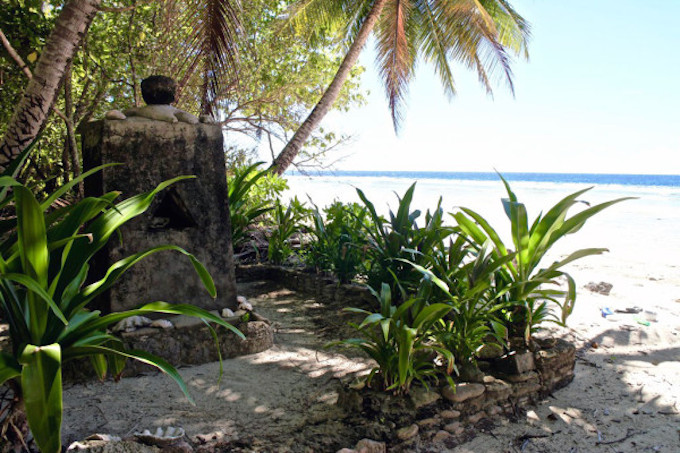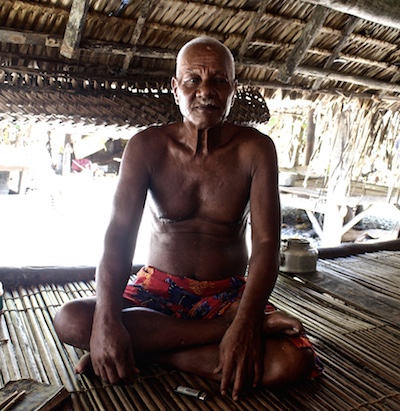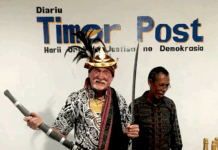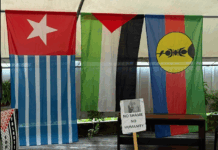
Report from National Geographic
By Janice Cantieri in Tarawa
“If, one day, the waves take away these sacred places and they’re gone, we will keep on telling the stories. But I can’t stop that—I don’t hold the answer of the waves.”
Takirua Tiare, a traditional storyteller on Kiribati’s Marakei Island, tells it how it is.
As a taani karaki, as the storytellers are known, Tiare, 68, is in charge of looking after Marakei’s four shrines and passing along their oral histories—stories of the island’s connection to spirits, gods and goddesses, and ancient battles—to the next generation.
These sacred places have been on the island for centuries. But in recent years, the rising seas that surround Marakei and the other Kiribati islands are creeping closer and closer to the shrines, particularly the one known as Nei Rotebenua.
“Before, the sea was far away from [Nei Rotebenua]. That place was more inland. Now it’s just over the beach, but it didn’t used to be,” Tiare explains.
But it’s not just the sea that has the island’s elders worried. Some feel that the younger generations are taking less interest in the community’s storytelling traditions. These two simultaneous threats, the elders say, endanger Marakei’s heritage: The sea is growing closer to the physical shrines just as interest in the history they represent wanes.
Te Katabanin: A Marakei Tradition
As I sat with Tiare in his thatched home, he explained the importance of paying respect to the shrines, which represent the island’s four goddesses. Upon arrival, newcomers to Marakei travel counterclockwise around the ring-shaped island in a practice called te katabanin. Visitors must leave offerings of tobacco or money at each shrine.

If they don’t, Tiare says, there is a good chance they will be cursed.
“When you are a visitor or guest, you must do te katabanin before anything else,” he says.
According to the legend,when King Kirata arrived here hundreds of years ago he sent half of his crew clockwise to explore the island, while the other half went counterclockwise.
“The ones that went clockwise died on the spot when they met again,” Tiare says.
“You will be all right if you do te katabanin counterclockwise, but not the other way.”
When I arrived on Marakei, I was immediately taken around the island on te katabanin with Rotite Mangaa, my neighbor in Rawannawi Village. When she first saw me, she excitedly jumped up and found a motorcycle to borrow for our journey.
To get to the first shrine, Nei Reei, we had to push the motorcycle through sandy patches on the island road. The February king tide was extremely destructive for Marakei, destroying large sections of the single road connecting the island’s villages.
Mangaa spoke quickly in the Kiribati language, blessing my stay on Marakei and asking the island goddess for protection. As soon as I placed my offering of tobacco on the shrine, children hovering nearby snatched it up to deliver to the village unimane (elder) who guards Nei Reei.
The second shrine, Nei Rotebenua, was right on the beach. After I made my offering, Mangaa covered our cheeks with sand from the beach, then gave me a hug.
“You now belong to Marakei,” she said.
When we returned to Rawannawi Village after visiting the last two shrines, Mangaa shouted to the villagers that the two of us were now “Marakei sisters.”
Moving a shrine: a sacred knowledge
Three of the island’s four shrines are far enough inland to avoid the high tides, but Nei Rotebenua is especially vulnerable and may eventually have to be moved further inland. It wouldn’t be the first time; Tennang Tokanako, an elder who lives nearby, explained that Nei Rotebenua was moved once before, about 15 years ago, when the tide washed away the old site.
There is a special way to move a shrine in his culture, Tokanako said, but many of the elders with that knowledge have already passed away—which could leave Nei Rotebenua in jeopardy.
“Nowadays there aren’t many people who know the process. These places are taboo and sacred, so I’m not sure if we’ll be able to move it or not.”
Like many of the elders on Marakei, Tokanako, 70, is worried that younger islanders have lost interest in preserving the island’s shrines and stories. If the shrines are lost, he’s concerned that the stories will be lost, too, unless the community makes an effort to preserve them.
“Now, I observe the next generation, and they all don’t care about the shrines,” he says. “They care about making money, development, and wanting to go to Tarawa, and they laugh at the shrines. It’s sad for me because very soon these things will be disappearing, but we can’t do anything about it.”
Toakin Wakarati, 48, another storyteller from Rawannawi Village, explained that the existence of the physical shrines is essential to preserving their stories.
“The stories are useless without the shrine there,” he says. “Te katabanin is still practiced and is one of the things that keeps the stories alive. Now, it’s been ages, and the reason the stories are alive is because those shrines are still there and everyone goes around to them.”
But other storytellers, like Takirua Tiare, say that even if these sites disappear, the storytelling will continue.
“If it’s meant to be gone, it’ll be gone. But us, we’ll keep on telling stories. If I keep telling the stories, maybe one of my children will be interested and keep the story alive.”
Janice Cantieri is a journalist and researcher from Milwaukee, Wisconsin, who is on a Fulbright-National Geographic Digital Storytelling Fellowship to document the stories of displacement and adaptation between the Pacific Island nations of Kiribati and Fiji. This article is republished with the permission of the author.












































